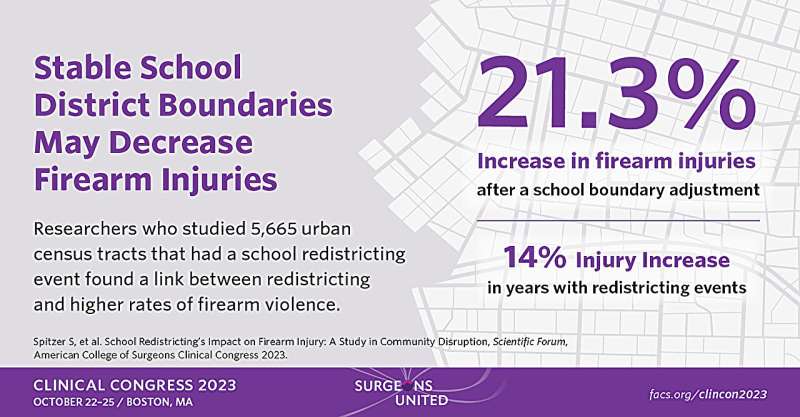This article has been reviewed according to Science X's editorial process and policies. Editors have highlighted the following attributes while ensuring the content's credibility:
fact-checked
trusted source
proofread
Study links school redistricting to higher rates of firearm violence in urban communities

Adjustments in school boundaries and other forms of school redistricting have been linked to spikes in shooting-related injuries in urban areas, according to new study results being presented at the American College of Surgeons (ACS) Clinical Congress 2023.
Sarabeth Spitzer, MD, MPH, a general surgery resident at Brigham and Women's Hospital in Boston, presented the study results looking at school redistricting data, firearm injury incident data, and community-level sociodemographic data for 63,000 urban census tracts on a year-to-year basis from 2014 through the 2019–2020 school year. The study used data from the National Center for Education Statistics, Gun Violence Archive, and the American Community Survey.
Key findings
- Among the studied census tracts, 5,665, or 1.5% of all tracts, had some type of school redistricting event.
- After adjusting for community characteristics, such as sociodemographic data, any school redistricting was associated with a 10.6% higher firearm incidence rate compared to communities that did not redistrict schools.
- School boundary adjustments specifically were associated with a 21.3% increase in firearm injury incidence rate.
Observations on study results
While the evidence linking social disruptions and community violence has been well vetted, this is the first study looking at school redistricting specifically, Dr. Spitzer said. Along with the existing evidence surrounding social disruptions, anecdotal evidence from teachers reporting that they noticed a spike in violence in the process of school redistricting provided rationale for the study, she said.
Dr. Spitzer explained how the study defined school redistricting: "School redistricting, at its most basic level, is when there are changes to where kids go to school based on their home address," she said. "This happens for various reasons, often due to resource distribution in a community."
Different types of redistricting exist, which the study doesn't specify, but they include combining or rearranging school districts and changing boundaries.
"Only a few kids are affected, but the resulting impact is that there is social destabilization in some way because, as everyone who has attended middle school and high school knows, you get to know the community that you're a part of and there are social hierarchies that exist and a known quantity of the people in your area," she said.
"When you have this shuffling of school districts, it means that there are new social interactions and new hierarchies that need to be formed. And you have a disruption as a result of that."
These disruptions not only impact children, but parents, as well, who may have to change work routines, and neighbors that families might rely on to watch out for their children, she said.
The study compared firearm incidents in census tracts for the year a school redistricting event occurred compared with the prior year. "We saw that in the year with a redistricting event, there was a 14% increase in firearm violence compared to the year prior," Dr. Spitzer said.
This means policymakers could target resources, such as sending in counselors and expanding training in the ACS STOP THE BLEED program, to address firearm violence in areas that undergo school redistricting, she added. The ACS STOP THE BLEED program provides training to anyone to save a life in a bleeding emergency. It has trained more than 3 million people. The ACS operates the program under a license granted by the Department of Defense.
Dr. Spitzer acknowledged the study data predate the COVID-19 pandemic. "We would love to have more recent data, but, if anything, what we saw in the pandemic was a huge spike in firearm violence," she said. "We think that part of that is actually due to social destabilization." Future research, hopefully, would draw on more recent data to investigate the relationship between school redistricting and firearm violence post-pandemic, she said.
Study co-authors are Tanujit Dey, Ph.D.; Ali Salim, MD, FACS; and Molly P. Jarman, Ph.D.; of Brigham and Women's Hospital.
More information: Spitzer S, et al. School Redistricting's Impact on Firearm Injury: A Study in Community Disruption, Scientific Forum, American College of Surgeons (ACS) Clinical Congress 2023.


















